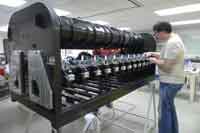
Posted to News on 17th Sep 2017, 00:00
The rise of the machines
According to industry commentators, machine building is one of the hot topics within UK manufacturing right now. Kieron Salter explains why this sector of the industry is experiencing a period of dynamic change that looks set to continue over the next decade.

First defined by industrial academics Tseng and Jiao back in 2001, the concept of mass customisation is finally making serious in-roads into consumer markets such as fashion, FMCG, automotive and sportswear. From bicycles to personalised spectacle frames, the ability to manufacture products designed specifically for an individual at low cost is now a reality.
This development was previously held back due to two key constraints; the cost of production and the availability of useable technology - both of which have now been largely overcome. The movement of global players such as Siemens, Bosch, Statasys, IBM and Dell into the Internet of Things (IoT) arena has meant that the cost of implementing Industry 4.0 solutions is falling as new products become available. And with the huge increase in data processing power (Moore’s Law), we have now reached the stage where large amounts of information can now be stored and interpreted into usable data.
Despite the inevitable hype and widespread misunderstanding around IoT, Industry 4.0, 4IR or M2M (all different terms for what is essentially the same trend in manufacturing), the future facing UK and European manufacturers is exciting. As designers and builders of systems, we now have the skills, technologies and systems to create a new era of intelligent machines to deliver the digital manufacturing dream.
I believe there are four main drivers to this digital revolution:
- Control systems
- Materials development
- Efficiencies and cost reduction
- Horizonal innovation
Control of data has always been one of the Achilles’ Heels of digital manufacturing. The data was always there, but it was a question of collecting, storing and then (crucially) harnessing that data to inform process decisions. Thanks mainly to the shift from big PLC control systems to PC-based tools, (provided by micro-control specialists such as Beckhoff), there is now much more flexibility and choice within the machine control environment. This fundamental shift in data management has enabled us to be much more dynamic and creative when it comes to developing digital manufacturing systems. Using PC-based controls, we are currently involved in the development of a game-changing digital Braille printer, that could transform the life of millions of blind and partially sighted people across the world when it enters volume production.
Materials development is another industry trend that is driving the new era in machine building. Indeed, the advancement of new, lighter composites with even better weight bearing properties, is opening up a new chapter in machine development. Last year, we designed and developed a digital printer for the textile sector, which enables mass customisation of wallpapers and other materials. This was only made possible by the use of lightweight composites to reduce the original weight by approximately 30%.
Efficiencies and costs savings are other obvious drivers of the digital manufacturing revolution. While it’s all very well predicting Industry 4.0’s potential productivity gains and waste reduction deliverables, there’s nothing quite as convincing as hard facts. A recent report from PwC highlights a number of tangible benefits already enjoyed by 2,000 responding digital manufacturers. While the vast majority of companies agreed that embracing digital manufacturing had enabled shorter operational lead times, higher asset utilisation and improved product quality; on average companies reported annual increases in digital incomes of 2.9% and cost reductions of 3.6%.
Horizontal innovation is the final trend that is accelerating the nascent digital machine building trend. Our adoption of many of the technologies, principles and materials pioneered in motorsport have informed our journey into digital machine building. The identification of technologies and solutions across industrial sectors is a key theme that has been adopted by the IET. Moreover, the Institution believes that UK PLC could benefit significantly from a more joined up approach to the sharing of knowledge across sectors.
KWSP’s active support of this strategy has led to us solving data control issues on a cycle wind tunnel project for Boardman Bikes, as well as reducing weight on numerous machine build projects. While not a central ingredient of change in the digital manufacturing sphere, the adoption of Horizontal Innovation principles is certainly a significant catalyst for change.
Granted, while there are potential constraints to anticipated growth - such as availability of skills, Brexit and the state of the global economy - the digital machine building market presents a significant opportunity for UK engineering to become a global innovator in this area. Perhaps our biggest constraint to growth is product manufacturers’ relatively poor understanding of the potential that digitization can offer. Then again, maybe it’s our job to spread the message.








